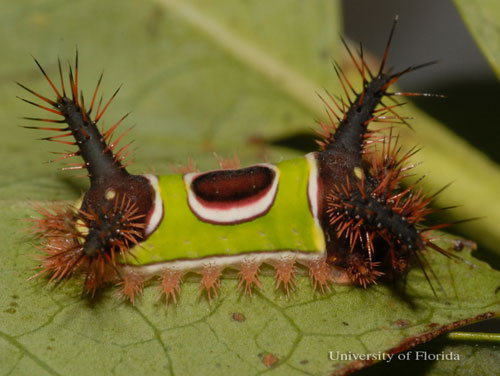
Late instar larva of the saddleback caterpillar, Acharia stimulea (Clemens) larva, on blueberry. Credit: Lyle J. Buss, University of Florida
With weather like this, you can’t help but get outside and explore. When stretching your legs and getting outside you are likely going to encounter caterpillars. While we typically associate these little critters with their transformation into butterflies or moths, they can also be painful. Did you know some caterpillars can sting?
While not like wasps and bees who have stingers, caterpillars “sting” in a different way. Caterpillars have either urticating hairs – barbed hairs that easily break off the caterpillar’s body when they come in contact with you, or spines (nettling hairs) that are connected to poison glands. The number of spines that embed in the skin and the persons individual reaction result in varying pain reactions. Some people experience severe reactions to the poison released by the spines and require medical attention. Others experience only an itching or burning sensation. Non the less, its best to avoid contact with caterpillars.
There are four major stinging caterpillars found in Florida are the puss caterpillar, saddleback caterpillar, Io moth caterpillar and hag caterpillar.
While some of these are more common than others, they can all be found in the state. This spring and into early summer while you are out on the trails, in the garden, or however you are enjoying this fresh spring air, keep an eye out for caterpillars. For help identifying caterpillars you can reference “Stinging and Venomous Caterpillars of the Southeast“ or contact your local county agent.
- Big Doe Contest Returns for 2025: A Growing Thanksgiving Tradition - November 14, 2025
- UF/IFAS Extension Panhandle Cattlemen’s College Announces Scholarship Opportunity for Florida Youth – Application Deadline September 15 - August 29, 2025
- Foot Rot Prevention and Treatment for Cattle - August 15, 2025
